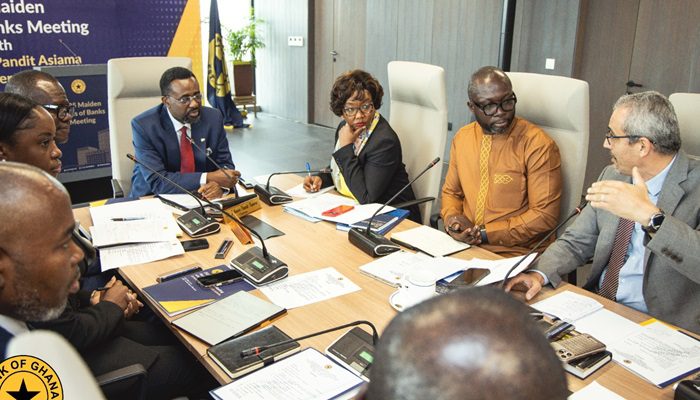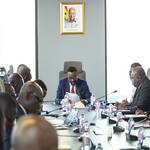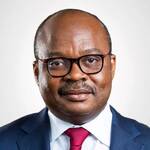The Bank of Ghana (BoG) and Chief Executive Officersm (CEO) of commercial banks held a high-level post-Monetary Policy Committee (MPC) meeting to discuss the recent monetary policy hike and the outlook in a move toward restoring macroeconomic stability to strengthen collective efforts to sustain economic recovery.
Held in Accra, the maiden post-MPC engagement brought together key stakeholders in Ghana’s financial sector to foster mutual understanding of policy decision and ensure alignment across the banking industry.
In attendance were CEOs or representatives of regulated banks in Ghana and officials of BoG, including the 1st Deputy Governor, Dr. Zakari Mumuni.
Though these meeting have been held under previous Governors, this is the first time media has been provided information on it for publication for public consumption.
Policy rate raised to reinforce disinflation
Giving an overview of the key discussions and macroeconomic developments, Governor of BoG, Dr. Johnson Asiama, explained that the MPC’s recent decision to raise the policy rate by 100 basis points to 28% was a proactive measure aimed at reinforcing the ongoing disinflation process.
“The disinflation trend is evident but remains too gradual to secure lasting stability,” Dr. Asiama said.
He cited recent data showing a drop in headline inflation—from 23.8% in December 2024 to 22.4% in March 2025—as evidence that earlier policy actions were taking effect. However, he cautioned that core inflation remains above target, while inflation expectations are still high.
Dr. Asiama noted that with private sector credit and broad money supply expanding, demand-side pressures could re-emerge if not kept in check.
Balancing vigilance with growth
To mitigate these risks, Dr. Asiama said the Committee had taken a forward-looking stance, mindful of recent experience which showed that delayed policy tightening could lead to more persistent inflation and costlier adjustments in the long run.
“The rate hike also strengthens our external buffers, supports the cedi, and signals our commitment to macroeconomic stability at a time of global uncertainty,” he explained.
Acknowledging that the higher policy rate could increase borrowing costs for businesses and households, the Governor said the BoG was confident that the financial system was resilient enough to absorb the shocks.
“We expect viable businesses to continue receiving credit support. At the same time, tailored solutions should be explored to cushion the most vulnerable sectors,” he added.
Dr. Asiama urged banks to act with prudence when adjusting lending rates and called for open, transparent communication with customers to help them navigate the economic landscape.
Stability in banking sector strengthening
The Governor also highlighted the progress made in restoring financial sector stability, despite prevailing economic headwinds. He attributed recent improvements to the successful execution of the Domestic Debt Exchange Programme (DDEP), strong bank profitability, and continued recapitalisation efforts.
According to BoG data, total assets in the banking sector grew by 34.05% year-on-year as of February 2025, with deposits rising by 27.89%.
The Banking Sector Soundness Indicator (BSSI) reflected improvements in solvency and asset quality, with most banks surpassing the 10% Capital Adequacy Ratio (CAR) regulatory threshold.
The industry average currently stands at 14.35%.
However, Dr. Asiama flagged solvency challenges among a few domestically controlled and state-owned banks where capital restoration plans remain unclear.
“Recapitalisation of these banks is a top priority. We are working closely with the affected institutions to reach sustainable capital levels, restore depositor confidence, and ensure regulatory compliance,” he assured.
BoG urges banks to strengthen risk management
In the face of growing credit risks, Dr. Asiama encouraged banks to enhance their risk management systems.
He called for improvements in underwriting practices, early warning systems, and provisioning models to mitigate potential losses.
He also emphasized the need to strengthen loan origination, credit monitoring, and review processes, warning that the sustainability of the sector depended on proactive risk controls.
Push for innovation and financial inclusion
Dr. Asiama further urged commercial banks to embrace innovation and strategic partnerships, especially in the digital finance space, to remain competitive and drive inclusive growth.
The BoG, he said, is committed to promoting a well-supervised financial ecosystem where innovation thrives without compromising consumer protection or financial soundness.
“We are deepening engagement with non-bank financial service providers to expand access, ensure innovation is safely integrated, and promote digital transformation in the sector,” he noted.
A collaborative path forward
Dr. Asiama reaffirmed the BoG’s commitment to working closely with banks to navigate economic uncertainties and build a resilient financial architecture that supports long-term national development.
“Our focus is to create a financial system that is inclusive, robust, and responsive to the needs of our economy. Through continued partnership with the banking industry, we can drive transformation and ensure shared prosperity,” he said.
- How one man’s CV defeated the Conservatives in Canadian elections - 4 May 2025
- How Ghana can grow its creative industry the Nigerian way - 4 May 2025
- JM, touch not the annointed - 3 May 2025




